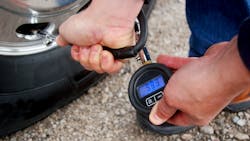For a fleet, tires are one of the biggest operating expenses after fuel, so a lot of money is riding on a vehicle’s wheels.
Choosing the right tire should be based on the size and needs of the fleet. It is important to pick the optimum tire, taking into consideration tire characteristics such as fuel economy, durability, traction, miles to removal, casing retreadability and price.
Your investment in tires is worth protecting, and it’s worth knowing how to maximize performance based on operational and maintenance factors. There are a number of things that should be monitored regularly, including proper tire inflation, routine tire rotation, irregular wear and tire casing integrity.
Developing a regular tire maintenance program is critical to attaining longer life from your tires.
Proper Tire Inflation
Maintaining proper inflation pressure in tires is the single most important factor in extending tire life. Both overinflation and underinflation have negative effects on the tire by changing its footprint – that is, the area contacting the road.
Underinflation can cause excessive heat buildup and can potentially lead to internal structural damage. Overinflation can make tires more vulnerable to cutting, punctures or damage from sudden impacts.
When the tire is not contacting the road as the tire design intended, its tread area will wear irregularly and, therefore, more rapidly. Correct inflation pressure is determined by the load carried for each tire.
Routine Tire Rotation
Routinely rotating tires directly contributes to longer tire life, especially in areas of irregular tread wear. Tire rotation can often improve tire wear, because when there is a change in the direction of the rotation, or when cross-rotating the tires, some irregular wear can be improved.
Roadmaster recommends rotating tires when they are 50 percent worn, or even earlier if they show signs of irregular wear. Changing the direction of rotation can also even out heel/toe wear on the shoulders of drive tires, and erratic wear on the shoulders of trailer tires.
Steer tires are normally rotated side-to-side, which changes the direction of rotation and helps even out wear.
At a 3/32” to 4/32” difference in tread depth between the drive axle tires, a cross-rotation would be recommended to even out the wear and increase tire life before removal.
Directional tires are the only tires that should not change their direction of rotation.
Trucks with dual drive axles should have a tire rotation if the wear gets to 3/32” to 4/32” difference from axle to axle. If irregular wear is noticed, a cause must be determined and the situation resolved.
Bead Seating and Tire Installation
Ensuring proper bead seating when mounting tires is also important to achieve optimal performance and tire life. Much irregular wear, and some ride vibration conditions, can be traced back to the original installation. An improperly seated bead creates uneven wear patterns and increases the chance for ride/vibration issues.
You can ensure the tire is properly seated by checking to see that the distance between the rim flange and the aligning ring is uniform around the complete circumference of the tire.
With the bead seated against the rim, the distance from the seating ring to the rim should be measured at four different points, each 90 degrees apart around the rim. The distance between the ring and the rim should be the same at all four points.
Tire Casing Integrity
Choosing the correct tire for your needs, maintaining air pressure, rotating tires and checking wear are integral to preserving tire casing integrity. Other factors include tire performance characteristics such as fuel economy, durability, traction, miles to removal, safety, price and casing retreadability.
Roadmaster believes that in order to get the most out of your tires, it’s important to find a tire that will provide long miles to removal, as well as one that takes into account the casing quality and belt package. The casing quality will tell you a great deal about the tire – how it will hold up and the value the tire has for its second and third life in retreading.
All Roadmaster tires, for example, are engineered for retreadability and are backed with a strong warranty of two retreads within six years.
Establish a Tire Maintenance Program
Roadmaster recommends that you implement a comprehensive maintenance program that includes regular inspections to check for proper tire pressure, tread depth and irregular wear. Properly maintained, serviced and inflated tires last longer, so fleets get the most from their tires.
One of the simplest things drivers can do is to inspect their tires prior to each trip to ensure that vehicle and trailer tires comply.
Consider using fleet management software to track tire wear. This can help identify any abnormal wear situations and facilitate timely removal of worn tires.
Using tire pressure monitoring systems (TPMS) on trucks, and continuous tire inflation systems (CTIS) on trailers in order to simplify and improve tire pressure maintenance, will quickly alert you to problems. Improved tire pressure maintenance will help improve fuel economy and tire wear.
Gary Schroeder is the director of the truck and bus tire business for Cooper Tire & Rubber Company (coopertire.com). Its Roadmaster commercial tires are designed and engineered in the U.S. by an experienced technical team. Roadmaster brings with it a strong heritage of innovative engineering and quality products that are optimized for performance, durability and retreadability.
